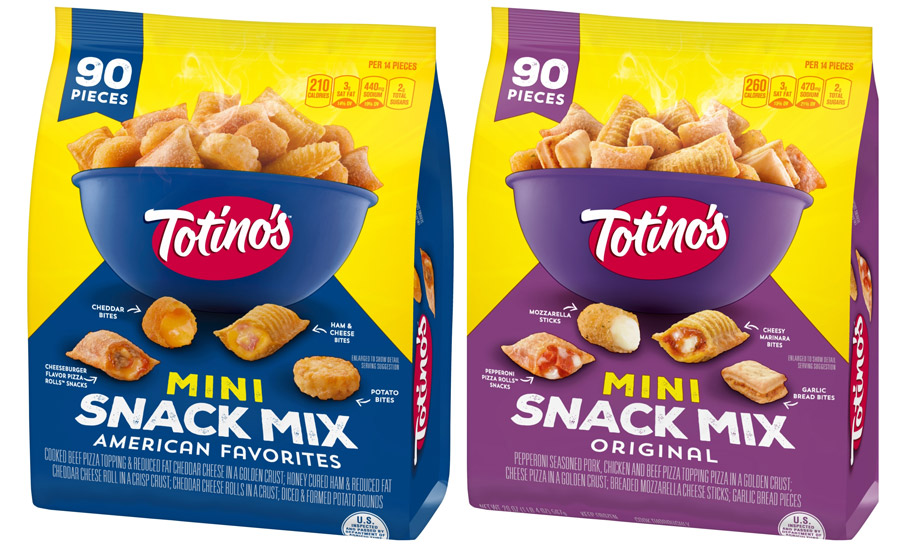State of the Industry 2020: Frozen snacks & appetizers see strong growth
The combination of convenience and classic, craveable product formats drives sales forward.












One of the fascinating aspects of today’s snack industry is the supreme flexibility of the term “snack.” Almost anything can constitute a snack, given the right portion size, its relative convenience, and requisite craveability. The range of grain-centric frozen snacks and appetizers available today—including pizza/snack rolls, ethnic appetizers, bagel bites, taquitos, and soft pretzels—fill that bill, and are often at home serving as after-school snacks, quick and easy entertaining options, or comforting sustenance while watching the big game—or even potentially supplanting part of a traditional meal.
Overview | Chips | Puffed/Extruded Snacks | Popcorn | Snack Mixes & Nuts | Tortilla Chips | Pretzels | Frozen Snacks | Crackers
Market data
As we have seen across much of the snack industry, 2020 is proving a strong year for core snack brands, with categories across the board seeing an uptick in dollar sales. The frozen appetizers and snack rolls segment grew a very nice 13.6 percent to $2.5 billion for the 52 weeks ending May 17, 2020, per IRI, Chicago, comprising the bulk of the slightly larger frozen appetizers and snack rolls category (which also includes frozen soft pretzels and frozen breaded vegetables). This is a significant uptick compared to last year, and nearly every company in the top 10 for the segment saw sales increases for the reporting period. Some of the top performers in the frozen appetizers and snack rolls segment for the year include:
- General Mills, Totino’s Pizza Rolls, up 12.1 percent to $680.4 million
- Ruiz Foods, El Monterey, up 5.1 percent to $308.3 million
- Kraft Heinz, Bagel Bites, up 16.6 percent to $189.4 million
- Rich Products Corp., Farm Rich, up 21.0 percent to $178.9 million
- Kraft Heins, Delimex, up 14.9 percent to $159.1 million
Schwan’s Co. reformulated and relaunched its Pagoda brand appetizers in 2019, and the efforts have paid off. The brand grew a significant 70 percent for the year, to a dollar sales total of $36.6 million. Its Minh brand also took off over the past year, up 193.3 percent to $20.3 million.
The frozen pretzels segment is dominated by J&J Snack Foods Corp., which controls nearly 85 percent market share. The company was up for the year, per IRI, growing 8.8 percent to $64.5 million. Its signature SuperPretzel line was up 7.3 percent to $43.0 million, while the SuperPretzel Soft Pretzel Bites line grew 44.5 percent to $4.9 million. Its Auntie Annie’s line likewise paid dividends, up 58.8 percent to $4.6 million in sales.
Looking back
The frozen snacks and appetizers category offers up a wide range of comforting classics. For instance, pizza rolls maintain enduring appeal due to the widespread love of pizza overall across the U.S. “Consumers continue to love pizza flavors,” says Jenny Huang, associate brand manager, Totino’s, General Mills, Minneapolis. “It’s hard to go wrong with pizza, given how familiar of a flavor it is to everyone.”
And the product format is incredibly convenient. “Consumers continue to look for convenient offerings, whether that’s products that can be heated up directly in its packaging, products with faster preparation, or products that can be taken on-the-go,” says Huang.
In August 2019, General Mills released its new Totino’s Mini Snack Mix, a product line that combines several favorite snacks and appetizers into one bag. Totino’s Mini Snack Mix Original includes Pepperoni Pizza Roll Snacks, Cheesy Marinara Bites, Mozzarella Sticks, and Garlic Bread Bites, while American Favorites includes Cheeseburger Pizza Roll Snacks, Ham & Cheese Bites, Cheddar Bites, and Potato Bites.
“Consumers are seeking flexible forms that can be used in multiple ways: as a personal snack, a family meal, or a snack that can be shared with friends,” says Rachel P. Cullen, president and CEO, Ruiz Food Products, Inc., Dinuba, CA. “Our El Monterey Taquitos are an example of a form that is growing quickly, because it meets all of these needs.”
Consumers also expect to find the new and exciting flavors that they are already finding in quick-service restaurants in the frozen snacks category, suggests Cullen. She also notes that protein continues to be an important attribute that consumers are looking for, so highlighting protein counts on product packaging can provide advantageous.
Ruiz Foods recently launched El Monterey Extra Crunchy Diablo Chicken Taquitos and El Monterey Nacho Cheese Taquitos. Both products include a callout highlighting the benefit of “6 g protein per serving” on the front of the package.
Frozen soft pretzel titan J&J Snack Foods routinely experiments with new product formats. One of the most-recent innovations to hit the foodservice market is the SuperPretzel Soft Pretzel Fries line, launched in early 2020. The company suggests menuing the vegan Pretzel Fries as an appetizer or as a side to an entrée, combining them with any array of on-trend or classic dipping sauces.
Looking forward
“The snack craze continued to gain momentum over the past year, and then COVID-19 isolation gave it an additional unexpected shot in the arm,” says Michael Holleman, director of culinary and marketing, InHarvest, Inc., Bemidji, MN. “The biggest trend we continue to see is consumers seeking out healthier or better-for-you options that satisfy their snacking desires, yet leave them feeling good about their choices.”
Gluten-free is another emerging opportunity for these products, suggests Holleman. “We are likely to see more gluten-free breadings capitalizing on crispy, toasted, and popped rice and grains as the rise in whole-grain usage continues to surge.”
Holleman suggests that offering solutions for specialty diets—keto, gluten-free, Paleo, raw, and vegan, to name a few—can pay off in a big way with a loyal following and growing customer base. “Products that cater to sustainable nutrition should have a welcomed entry into the marketplace,” he says. “Naturally high-protein grains and legumes are a regular inclusion in many vegan and vegetarian products, but they also can co-exist with animal proteins to add texture, flavor, and marketability—all while helping reduce ingredient costs as the cost of animal proteins continues to escalate.”
Retail product developers often look to foodservice for inspiration, and the appetizer menu can often provide some food for thought when it comes to R&D planning.
“Pizza is having a good year in general,” says Mike Kostyo, Trendologist, Datassential, Chicago. “Pizza has long been America’s favorite food overall, but as we headed into stay-at-home orders in March, consumers told us they were craving pizza more than any other food—it’s comforting, delivers well, and pleases the whole family. In fact, nostalgic offerings like pizza rolls and pizza bagels have seen a resurgence in popularity.”
Wontons and dumplings are seeing increased presence on menus, notes Kostyo. “Wontons and wonton-based appetizers, dumplings, and egg rolls are the most-common Asian-inspired appetizers on menus, with all of them above 10 percent menu penetration,” he says. “However, while egg rolls have seen a dip in menuing recently, wontons and dumplings continue to increase their menu penetration.”
To make egg rolls exciting again, suggests Kostyo, consider infusing them with other trending Asian flavors and ingredients, like Korean barbecue. “Across the appetizer menu, flavors like ginger and soy are also up 18 percent and 9 percent in the past four years, respectively.” He also notes that, on the Latin American side of things, menu penetration of mini tacos is up 9 percent.
The soft pretzel market is seeing great growth in foodservice. “You can’t go wrong with pretzels,” says Kostyo. “In fact, pretzels are actually the fastest-growing non-fried appetizer option on menus today, growing 36 percent in the past four years. There’s no end to the innovation we’re seeing with pretzels, from using them as carriers to pretzel dippers with queso or beer cheese to giant Instagrammable pretzels hanging from hooks.”
Plant-based dietary benefits continue to infiltrate nearly every aspect of snacking, and the historically indulgent frozen snacks and appetizers category might be next.
“We believe more consumers will be adopting a ‘flexitarian’ lifestyle, looking to add plant-based sources of protein to their preferences,” says Cullen.
Huang notes that spicy snacking is growing in other categories such as salty snacks, yet there aren’t many spicy offerings in frozen snacks and appetizers outside of Buffalo chicken and jalapeño poppers. “We will start to see more spicy product offerings in frozen as a way of providing more flavor variety to consumers,” she says.
There’s also a value proposition that needs to factor into the discussion moving forward. “Frozen snacks and appetizers work well for families on a budget since there is less concern about spoilage and food going to waste,” says Huang. Given COVID-19 and its impact on the economy, she says, more families will be increasingly budget-conscious, looking for products that provide good value.
“As we stock up our refrigerators and freezers these days, we are often stocking them with comfort foods and foods that are easy to prepare,” says Frank Flider, consultant, QUALISOY, Chesterfield, MO. “However, the consumer won’t give up flavor and nutrition for convenience. Whether in frying or baking applications, there are high-oleic soybean oils and shortenings that will provide the functionality and shelf life snack food manufacturers depend on, with a flavor that consumers desire. As high-oleic soybeans are 100 percent U.S. grown, sourcing high-oleic soybean oil and shortening supports American farmers.”
Flider also notes that, in the current climate, foodservice operators will appreciate products that streamline their production. “High-oleic soybean oil’s improved resistance to oxidation results in reduced buildup on fryers, meaning less equipment maintenance. Its extended fry life—greater than 25 OSI (oil stability index)—can result in cost savings.”
There’s a strong sustainability message that can factor into the next generation of frozen snacks and appetizers. According to the United Soybean Board’s “Food Industry Insights” study, 73 percent of consumers believe in supporting domestic agriculture by buying foods made with U.S.-grown ingredients, says Flider. The same number of consumers said that eating foods produced by sustainable practices is important to them.
“To meet the demand for sustainable and domestically grown ingredients, companies are seeking oil solutions that fit these criteria without compromising functionality or quality,” says Flider. “Around the world, current events are affecting the production and availability of some ingredients, making it important that domestic sources are available. During this time of crisis, U.S. soybean farmers are committed to provide a secure food supply.” He suggests that high-oleic soybean oil and high-oleic soybean shortenings, produced exclusively from U.S.-grown soybeans, offer a sustainable and functional solution.
Holleman notes that “The Future of Ingredients: 2020” report from Mintel suggests that the next wave of healthy ingredients will also support the health of the planet. “There is growing conversation around regenerative agriculture and how it could, indeed, become the new organic,” he says. “Capitalizing on this now will not only capture a largely untapped customer base, it will also help support the farmers who continue to try and meet the growing demand. Product developers who are able to bring the next new interesting ethnic-inspired snacks containing regen-ag ingredients will no doubt have an edge on their competition.”
Overview | Chips | Puffed/Extruded Snacks | Popcorn | Snack Mixes & Nuts | Tortilla Chips | Pretzels | Frozen Snacks | Crackers
Looking for a reprint of this article?
From high-res PDFs to custom plaques, order your copy today!












